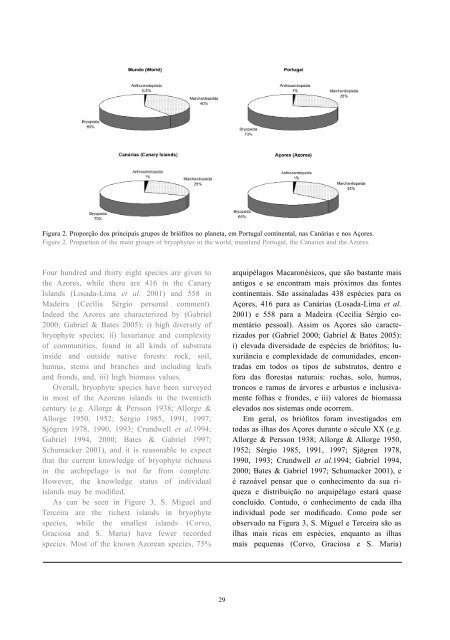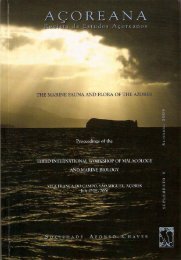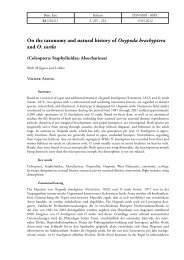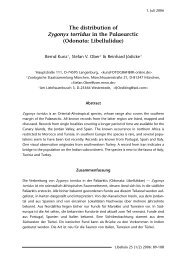(eds.) (2005). - Portal da Biodiversidade dos Açores - Universidade ...
(eds.) (2005). - Portal da Biodiversidade dos Açores - Universidade ...
(eds.) (2005). - Portal da Biodiversidade dos Açores - Universidade ...
Create successful ePaper yourself
Turn your PDF publications into a flip-book with our unique Google optimized e-Paper software.
Figura 2. Proporção <strong>dos</strong> principais grupos de briófitos no planeta, em Portugal continental, nas Canárias e nos <strong>Açores</strong>.<br />
Figure 2. Proportion of the main groups of bryophytes in the world, mainland Portugal, the Canaries and the Azores.<br />
Four hundred and thirty eight species are given to<br />
the Azores, while there are 416 in the Canary<br />
Islands (Losa<strong>da</strong>-Lima et al. 2001) and 558 in<br />
Madeira (Cecília Sérgio personal comment).<br />
Indeed the Azores are characterized by (Gabriel<br />
2000; Gabriel & Bates <strong>2005</strong>): i) high diversity of<br />
bryophyte species; ii) luxuriance and complexity<br />
of communities, found in all kinds of substrata<br />
inside and outside native forests: rock, soil,<br />
humus, stems and branches and including leafs<br />
and fronds, and, iii) high biomass values.<br />
Overall, bryophyte species have been surveyed<br />
in most of the Azorean islands in the twentieth<br />
century (e.g. Allorge & Persson 1938; Allorge &<br />
Allorge 1950, 1952; Sérgio 1985, 1991, 1997;<br />
Sjögren 1978, 1990, 1993; Crundwell et al.1994;<br />
Gabriel 1994, 2000; Bates & Gabriel 1997;<br />
Schumacker 2001), and it is reasonable to expect<br />
that the current knowledge of bryophyte richness<br />
in the archipelago is not far from complete.<br />
However, the knowledge status of individual<br />
islands may be modified.<br />
As can be seen in Figure 3, S. Miguel and<br />
Terceira are the richest islands in bryophyte<br />
species, while the smallest islands (Corvo,<br />
Graciosa and S. Maria) have fewer recorded<br />
species. Most of the known Azorean species, 75%<br />
29<br />
arquipélagos Macaronésicos, que são bastante mais<br />
antigos e se encontram mais próximos <strong>da</strong>s fontes<br />
continentais. São assinala<strong>da</strong>s 438 espécies para os<br />
<strong>Açores</strong>, 416 para as Canárias (Losa<strong>da</strong>-Lima et al.<br />
2001) e 558 para a Madeira (Cecília Sérgio comentário<br />
pessoal). Assim os <strong>Açores</strong> são caracteriza<strong>dos</strong><br />
por (Gabriel 2000; Gabriel & Bates <strong>2005</strong>):<br />
i) eleva<strong>da</strong> diversi<strong>da</strong>de de espécies de briófitos; luxuriância<br />
e complexi<strong>da</strong>de de comuni<strong>da</strong>des, encontra<strong>da</strong>s<br />
em to<strong>dos</strong> os tipos de substratos, dentro e<br />
fora <strong>da</strong>s florestas naturais: rochas, solo, humus,<br />
troncos e ramos de árvores e arbustos e inclusivamente<br />
folhas e frondes, e iii) valores de biomassa<br />
eleva<strong>dos</strong> nos sistemas onde ocorrem.<br />
Em geral, os briófitos foram investiga<strong>dos</strong> em<br />
to<strong>da</strong>s as ilhas <strong>dos</strong> <strong>Açores</strong> durante o século XX (e.g.<br />
Allorge & Persson 1938; Allorge & Allorge 1950,<br />
1952; Sérgio 1985, 1991, 1997; Sjögren 1978,<br />
1990, 1993; Crundwell et al.1994; Gabriel 1994,<br />
2000; Bates & Gabriel 1997; Schumacker 2001), e<br />
é razoável pensar que o conhecimento <strong>da</strong> sua riqueza<br />
e distribuição no arquipélago estará quase<br />
concluído. Contudo, o conhecimento de ca<strong>da</strong> ilha<br />
individual pode ser modificado. Como pode ser<br />
observado na Figura 3, S. Miguel e Terceira são as<br />
ilhas mais ricas em espécies, enquanto as ilhas<br />
mais pequenas (Corvo, Graciosa e S. Maria)

















